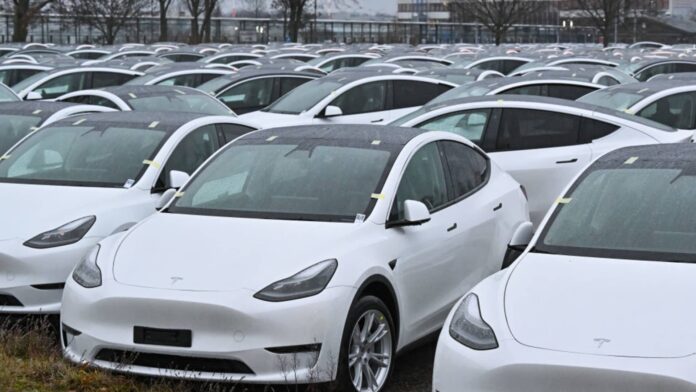Tesla’s decision to lower its prices has broad implications across the electric-vehicle industry — and may have started a price war. Tesla cut prices of the Model 3 and Model Y in the U.S. and Europe last Friday, which may help buyers qualify for more federal tax credits and boost sales volume. The Model 3 is Tesla ‘s entry-level sedan, while the Model Y has been classified as either a sport utility vehicle or a crossover. The company also lowered the price of its Model S sedan and falcon-wing SUV Model X in the U.S. “TSLA’s material price cuts on Friday may force an industry-wide price correction,” Wells Fargo analyst Colin Langan wrote in a note on Tuesday. The move will likely draw buyers who previously have not considered Tesla, and other car manufacturers will need to respond, he added. TSLA 1Y mountain Tesla’s 12-month slide. Yet Tesla has the upper hand when it comes to being able to afford those price cuts, suggested Jefferies analyst Philippe Houchois. Jefferies has a buy rating on Tesla and a $180 price target, implying 47% upside from Friday’s close. “The aggressive round of price cuts reverse 2022 price increases and would confirm Tesla has more levers to pull than any [original equipment manufacturer] given starting margins, capacity and opportunities to leverage growth into cost and revenue management,” Houchois wrote in a note Tuesday. Tesla’s move also comes as incumbent automakers have been raising prices, Bank of America analyst John Murphy highlighted. “Lower pricing on EVs could spur stronger demand, driving higher volumes and thereby accelerating the shift away from internal combustion engine (ICE) vehicles,” Murphy wrote in a note on Tuesday. Both Murphy and Wells Fargo’s Langan see a more challenging time ahead for Ford and General Motors as a result of Tesla’s price cuts. Ford EVs include the F-150 Lightning and the Mustang Mach-E, while GM’s Bolt is expected to be joined by a Blazer EV and Silverado EV later this year. Tesla has stronger profit margins than the incumbent automakers, and the room to reduce prices further, said Murphy, who has a neutral rating on Tesla. If Ford and GM respond with 5% price cuts of their own, versus Wells Fargo’s 2.5% forecast, the bank’s adjusted income before interest and taxes (EBIT) estimates on the automakers would fall about $3.5 billion, Langan said. In addition, Ford and GM are building out EV capacity. Given the potential for price reductions and therefore weaker margins, they will now have to reevaluate those investments, Bank of America’s Murphy added. “We anticipate F and GM will continue down the current path, but likely at greater risk to margins than we had previously expected,” he said. “Ultimately, these companies will have to seek out ways to build EVs even more cost efficiently and focus on segments where they may have unique advantages such as trucks and SUVs.” However, Societe Generale believes Tesla price cuts remove some of the mystery that has surrounded it, and could refocus attention on positive moves by legacy automakers. Ultimately, it could drive a re-rating for the likes of Mercedes-Benz, BMW, Volkswagen and Stellantis, analyst Stephen Reitman wrote in a note Monday. “It is not that Tesla has such an insurmountable lead that it is game over for legacy auto makers,” Reitman said. “2023 could be the year when the market begins to appreciate that some legacy automakers have what it takes to be very successful in a zero emissions world as well. Given their beaten-up valuations, that could spur renewed interest in the sector.” One clear winner from stronger EV demand is auto suppliers, Bank of America’s Murphy wrote. Murphy’s latest report reacting to the Tesla decision didn’t highlight any specific beneficiaries among auto suppliers, but he currently carries buy ratings on Adient and Lear. ‘Torn’ on TSLA Analysts were also quick to point out that Tesla’s price cuts will no doubt affect its own bottom line. Bernstein analyst Toni Sacconaghi lowered his 2023 earnings-per-share estimate to $3.80 from $4.96, saying Tesla’s lower prices will have a “huge” impact on Tesla’s economics. “We remain torn on TSLA’s stock,” wrote Sacconaghi, who has an underperform rating on the stock. His $150 price target implies 23% upside from Friday’s close. The stock is now trading at close to Bernstein’s 2050 discounted-cash-flow estimate of $120 a share, investor sentiment is poor and if consensus numbers are appropriately reset, there could be limited downside risk to estimates, he said. “That said, it is unclear if consensus numbers will get reset sufficiently and whether Tesla could still struggle with demand issues over the course of the year. Recent demand challenges also raise questions on whether long term forecasts for Tesla’s market share and margins may be too high,” Sacconaghi said in Tuesday’s note. — CNBC’s Michael Bloom and Lora Kolodny contributed reporting.
© heardonwallstreet.com


